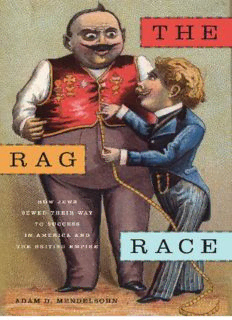
The Rag Race: How Jews Sewed Their Way to Success in America and the British Empire PDF
Preview The Rag Race: How Jews Sewed Their Way to Success in America and the British Empire
The Rag Race THE GOLDSTEIN-GOREN SERIES IN AMERICAN JEWISH HISTORY General editor: Hasia R. Diner We Remember with Reverence and Love: 1929: Mapping the Jewish World American Jews and the Myth of Silence Edited by Hasia R. Diner and Gennady after the Holocaust, 1945 – 1 962 Estraikh Hasia R. Diner An Unusual Relationship: Evangelical Is Diss a System? A Milt Gross Christians and Jews Comic Reader Yaakov Ariel Edited by Ari Y. Kelman Unclean Lips: Obscenity, Jews, and All Together Different: Yiddish Socialists, American Literature Garment Workers, and the Labor Roots Josh Lambert of Multiculturalism Hanukkah in America: A History Daniel Katz Dianne Ashton Jews and Booze: Becoming American in The Rag Race: How Jews Sewed Their the Age of Prohibition Way to Success in America and the Marni Davis British Empire Jewish Radicals: A Documentary History Adam D. Mendelsohn Tony Michels The Rag Race How Jews Sewed Their Way to Success in America and the British Empire Adam D. Mendelsohn a NEW YORK UNIVERSITY PRESS New York and London NEW YORK UNIVERSITY PRESS New York and London www.nyupress.org © 2015 by New York University All rights reserved References to Internet websites (URLs) were accurate at the time of writing. Neither the author nor New York University Press is responsible for URLs that may have expired or changed since the manuscript was prepared. Library of Congress Cataloging-in-Publication Data Mendelsohn, Adam, 1979– The rag race : how Jews sewed their way to success in America and the British Empire / Adam D. Mendelsohn. p. cm. — (The Goldstein-Goren series in American Jewish history) Includes bibliographical references and index. ISBN 978-1-4798-4718-1 (cl : alk. paper) 1. Clothing trade — U nited States — H istory — 1 9th century. 2. Clothing trade — United States — H istory — 2 0th century. 3. Jews — U nited States — E conomic conditions — History. 4. Jews — E ngland — E conomic conditions — H istory. 5. Success in business — United States — H istory — 1 9th century. 6. Success in business — U nited States — History — 20th century. I. Title. HD9940.U4M45 2014 331.6'3924073 — dc23 2014018129 New York University Press books are printed on acid-free paper, and their binding materials are chosen for strength and durability. We strive to use environmentally responsible suppliers and materials to the greatest extent possible in publishing our books. Manufactured in the United States of America 10 9 8 7 6 5 4 3 2 1 Also available as an ebook For Odette and Enid, a model mother and a much-missed grandmother This page intentionally left blank Contents Introduction: The Rag Race 1 1 Goblin Market: London, 1843 18 2 New York City: A Rag-Fair Sort of Place 37 3 Rumpled Foot Soldiers of the Market Revolution 58 4 Clothing Moses 91 5 The Empire’s New Clothes 112 6 A New Dawn in the West 134 7 Clothing the Blue and Gray 159 8 A Ready-Made Paradise 183 Conclusion 207 Acknowledgments 229 Notes 233 Index 287 About the Author 297 vii This page intentionally left blank Introduction The Rag Race Why have Jews prospered so dramatically in the United States? Their ascent has been exceptional. Other ethnic groups have succeeded in America, but none quite like the Jews.1 So what was the alchemy that transmuted them from economically abased immigrants to among Amer- ica’s most successful citizens? Were they successful because they were Jews or because of the particular circumstances they encountered in the United States? And can their recipe for success be distilled and reproduced by the nation’s newest immigrants? Most of those who address these questions today tread gingerly on turf first turned by an earlier generation more comfortable with racial and reli- gious essentialism and determinism.2 Instead of heredity, scholars are now more inclined to point to social and cultural capital — kinship networks, hard-won commercial expertise, attitudes toward education and com- merce, supportive institutions, and group solidarity — as key to explain- ing the economic success of Jews.3 Shying from earlier claims that Jews possess immutable and innate features derived from the primordial past (that gelt was in their genes) most historians and sociologists now assume that these traits and tendencies were acquired over time, like protective cladding against the dread chill of an inhospitable climate (the view that gelt is in their jeans).4 Restrictions that had long kept Jews on the fringes of the formal economy in the medieval and early modern periods, so one version of this argument goes, compelled them to develop skills and a mentalité that stood them in good stead in America. Others emphasize adaptations of more recent origin. Jews who flocked to America’s shores in the nineteenth century from central Europe, for example, had been exposed to public education and bourgeois values before their departure 1
Description: